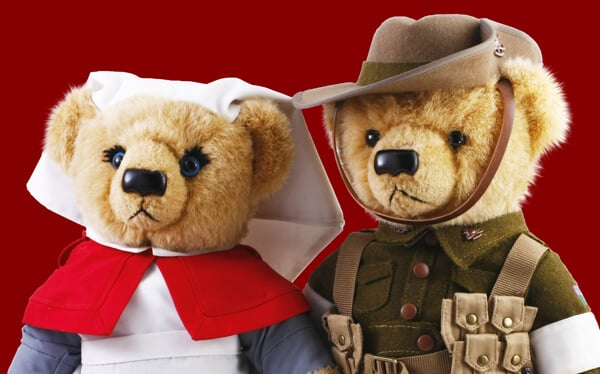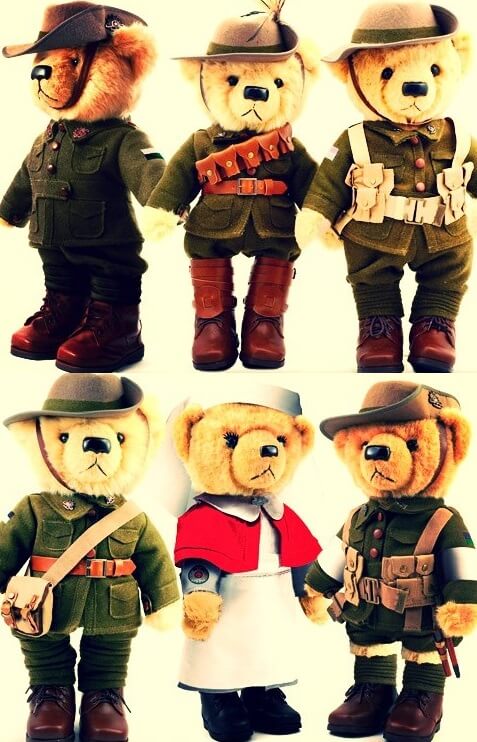
THE LOVE OF A TEDDY BEAR
A series of beautiful Great War Bears, released for the Anzac Centenary, have been winning the hearts of Australians across the country. The bears provide financial support to today’s Diggers through veteran’s charity Soldier On. The collection has gathered a cult following due to its support for modern soldiers and its close attention to historical detail. Each bear has been lovingly designed as a historically accurate reflection of uniforms worn by the AIF during the Great War.
 Private Murray, Trooper Jones, Private Harvey,
Private Murray, Trooper Jones, Private Harvey,
Private Thomas, Sister Bernadette, Corporal Cohen
One example of this historical perfectionism was the arduous research put in to securing actual vacant AIF service numbers for each bear. These service numbers were created during the Great War but became vacant for a variety of reasons, often due to the habit of some recruits to reject authority and simply wander off. Great lengths also went into ensuring names accurately reflected the times while also avoiding using the names of any real Diggers who fought for Australia.
The bear was selected instead of a native marsupial because of the historical links between the Teddy Bear and the Great War 1914-1918. The outbreak of the war in July-August 1914 had a marked impact on the humble Teddy Bear. Until the war most of Europe and England's Teddy Bears were sourced from Germany. With supplies cut off, English manufacturers stepped up to the challenge of supplying the empires children with the basic comfort of a friend in a time of hardship and family separation.
In the process they added a much softer English flavour to the Teddy Bear. Toy bears have changed much over the past century but they remain a symbol of affection and hope. The Great War Bears have been directly modelled on one of these softer English designs used a hundred years ago. Australian servicemen would have seen these toys while in Europe, especially while on leave, recuperation or healing in England.
The collection began with the unique Private Murray, the Diggers’ Bear, to mark the beginning of the Anzac Centenary. Private Murray wears the 1912 design uniform worn by Diggers in Europe and in the Middle East topped by the distinctive Australian Commonwealth Military Forces slouch hat proudly worn by the Australian Army since 1903. His uniform displays the white over green colour patch of the 4th Battalion; this battalion formed part of the 1st Brigade of the 1st Division and during the war it fought at Gallipoli and in the trenches of the Western Front.
Successive Great War Bears have met with equal affection, especially amongst descendants of Anzacs who served in the particular battalions or specialisations represented by each bear. For example Corporal Cohen wears the standard dismounted troops' uniform and webbing but with trousers cut to shorts in the Gallipoli summer. His white armbands and back patch were worn to help diggers identify 'friendly' soldiers in the heat of the battle. While Private Harvey, the Gallipoli Centenary Bear, wears the standard AIF webbing, complete with water canteen, bayonet and helve (the handle for his entrenching tool).
By popular demand the collection has also expanded to include bears that represent specialist roles. The aptly titled Private Thomas, the Gallipoli Stretcher-Bearer Bear, comes complete with a Field Dressing Haversack. Medics didn't wear the standard webbing; rather they had only a leather belt and haversack. Private Thomas looks bear beside the more finely equipped Trooper Jones, the Light Horse Bear, who wears the colour patch of 5 LH Regiment, which was raised in Queensland in September 1914 and fought at Gallipoli and then with the ANZAC Mounted Division in the Middle East. Much like the Light Horseman Jones has an air of superiority about him and sports a real emu feather as his plume.
However, the bear that was most widely demanded before even being designed was Sister O'Meara, the Nurse Bear. Her uniform represents the 'working dress' of the Australian Army Nursing Service and includes zephyr grey dress with white collar, white veil and scarlet cape; her rank of Sister is shown by the stars or 'pips' worn on her epaulettes, which are accompanied by curved bronze 'AUSTRALIA' titles. She wears the Rising Sun badge at her throat as a brooch and the cloth badge of the Australian Army Nursing Service is displayed on her right sleeve. Sister O'Meara has seduced many among the cult following into buying a mate for their Great War Bear.
Much of the public following behind the bears has responded enthusiastically to the release of adorable, though highly accurate, miniature medal sets. These replica medal sets are designed to perfectly fit each Great War Bear. Each set has three miniature replica medals, swing mounted, including the 1914-15 Star, British War Medal and Victory Medal. This was the most common set of medals that Australian veterans serving from Gallipoli to the end of the war would have been awarded.
A key force behind the close attention to detail, evident in everything from the historic patches to the real Emu feathers worn by Trooper Jones, is the collections Senior Designer who is the son of a Vietnam War veteran and nephew of a decorated Australian Army Corporal. The bears have been embraced by shopkeepers and happy owners across Australia. The Great War Bears will continue to be lovingly designed and manufactured throughout the Anzac Centenary.













